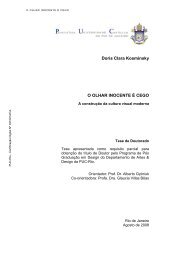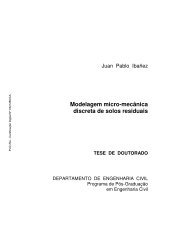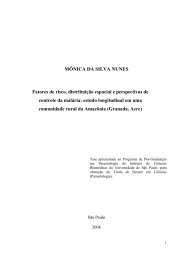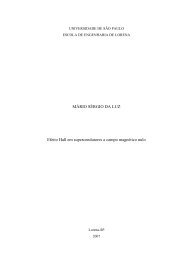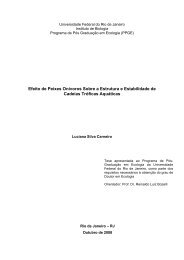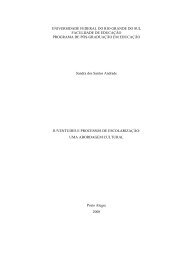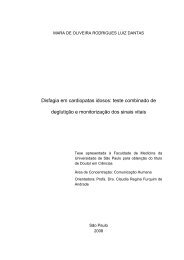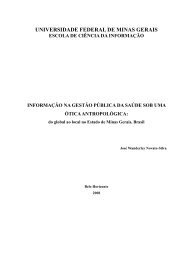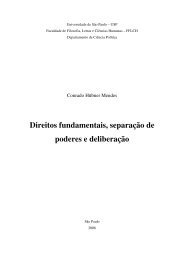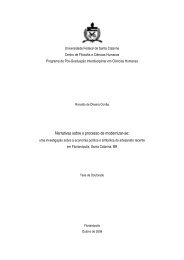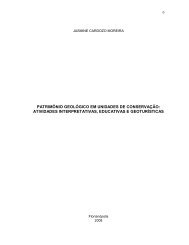You also want an ePaper? Increase the reach of your titles
YUMPU automatically turns print PDFs into web optimized ePapers that Google loves.
Promiscuous <strong>gene</strong> expression in murine FTOC14·74·74·74·73·14·7Chromosomal location of differentially expressed<strong>gene</strong>sThe genomic distribution of the 192 <strong>gene</strong>s modulated(repressed or induced) during the 5 days of FTOC developmentallowed for the co-ordinated expression of organizingchromosomal clusters.Figure 4 shows the frequency distribution of therepressed and induced <strong>gene</strong>s among chromosomes. Takingall the developmental phases together, the number ofrepressed <strong>gene</strong>s (154) was greater than that of induced<strong>gene</strong>s (38). All chromosomes, except Y, harboured differentiallyexpressed <strong>gene</strong>s, with a slightly biased distributionon chromosomes 2, 5, 11 and 19 for repressed <strong>gene</strong>s an<strong>do</strong>n chromosomes 3, 4, 11, 15 and 19 for induced <strong>gene</strong>s.Discussion9·53·1 1·63·16·314·711·1PGE in the thymus is a complex phenomenon observedin humans and mice, which is exhibited by TECs (mTECs)4·73·13·13·1CirculatoryCentral NervousDigestiveEpidermis/SkinEyesFat tissueGlandsIntestinesLocomotoryLymphoidMusclesPeripheral NervousReproductiveRespiratorySensory OrgansStem cellsUrinaryFigure 3. Representation of tissue/organ system-specific <strong>gene</strong> expressionin 20 days FTOC.Frequency (%)14 Repressed Induced1210864201 2 3 4 5 6 7 8 9 101112 13 14 15 16 17 18 19 X Y NFChromosomesFigure 4. Chromosomal distribution of the repressed and induced<strong>gene</strong>s considering all FTOC development (15–20 days).NF, not found.and involves 5–10% of all known <strong>gene</strong>s of these species.This process is a guarantee of self-representation ofmost parenchymal tissues and organs during the centraltolerance of T cells.Using PCR, Derbinski’s group previously demonstratedthat the expression of five tissue-specific <strong>gene</strong>s, such asthyroglobulin, CRP, GAD67, insulin and albumin, wasdetectable only in mTECs purified from ex vivo thymictissue at embryonic day 15 (E15). 7Accordingly, the complexity of PGE increases in, fromcTECs to immature mTECs to mature CD80 hi mTECs.These different <strong>gene</strong> pools are not complementary, butadditive, that is, there is no apparent association betweenthe respective molecular/biological functions of the <strong>gene</strong>sin parenchymal organs. The significance of PGE in thethymus is associated with the central tolerance of Tcells. 9–14While PGE by mTECs was well <strong>do</strong>cumented by theauthors cited above, many aspects of this phenomenonremain unexplored, for example, its evaluation in the thymusof autoimmune strains and/or knockout mice, itsmodulation by means of cytokines or other moleculesinterfering in <strong>gene</strong> expression, such as RNA interference,and its time–course during the onto<strong>gene</strong>tic developmentof the thymus.Molecular characterization of PGE in the FTOC modelsystem is a relevant approach in immunobiology, becausethe functional analysis of T-cell development has becomepossible after the introduction of techniques in which thethymic microenvironment is mimicked, such as FTOC.This method is based on the use of early fetal thymus tissue,which is composed of a homo<strong>gene</strong>ous thymocytepopulation (<strong>do</strong>uble-negative cells).In this study, the occurrence of PGE in vitro in FTOCis described for the first time. To evaluate whether PGEin this model system is a development-dependent phenomenon,we regarded the differential <strong>gene</strong> expressionduring ontogeny by comparing days of gestation (p.c.), asthe most informative in the delineation of the <strong>gene</strong> pool.Use of the FTOC model system was chosen, rather thancompare the changes in expression profiles in thymustissue obtained at different gestational days, to approachthree important aspects simultaneously. Since FTOCreproduces the in vivo thymus development, this modelsystem represented a useful tool first, for the fine demarcationof PGE onset and, second, to demonstrate thatPGE is a phenomenon that can be reproduced in vitro.The third aspect was a beneficial possibility of the FTOCmodel system, comparing the same pool of thymus tissueat day 15 with later time-points.We demonstrated that PGE in FTOC, which is characterizedby the overexpression of parenchymal organ andtissue-specific antigen <strong>gene</strong>s, emerges at 20 days p.c.(Fig. 1). Since this in vitro organ culture mimicked thethymus gestation in vivo, including the maturation of TÓ 2006 Blackwell Publishing Ltd, Immunology, 119, 369–375 373



